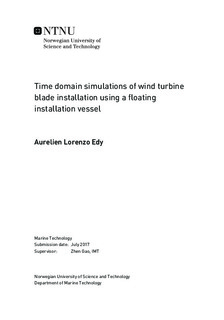| dc.description.abstract | This paper is aimed to assess the feasibility of the mating of the blade of an OWT by a floating installation vessel. A state of the art analysis of the current practices in the industry shows that jack-up vessels are preferred when it comes to top turbine installation. As the mating of the top turbine components happens at large heights and needs a high degree of precision, the use of jack-up crane vessels that have no wave-induced motions seems relevant. However, the drawbacks of the jack-up operations, such as the important time spent in the leg deployment and the costs of such operations, motivated the writer of this thesis to look for other innovative installation methods. The modeling of a innovative design of tower ring concept, introduced by De Groot, is realized to assess the feasibility of blade mating with floating vessel. This modeling, performed with the use of the software SIMO, leads to the establishment of the limiting environmental conditions for performing the operation. The results show that the impact of the turbulent wind on the lifted blade is not as critical as the impact of the vessel motions due to the waves. These wave-induced motions are even more critical when the waves are coming from the side of the moored installation vessel.
The comparison with the jack-up installation shows that jack-up operations accept limiting sea states of wider significant wave heights and peak periods than the floating vessel installation. One additional problem of the floating vessel is the effect of the mean wave direction, which can limit drastically the allowable sea states when the vessel is not facing the waves. However, the operational time with floating vessels is almost divided by half for a total wind turbine installation compared with the jack-up vessels. The relevance of floating vessels for OWT installation must therefor continue to be investigated. | |

